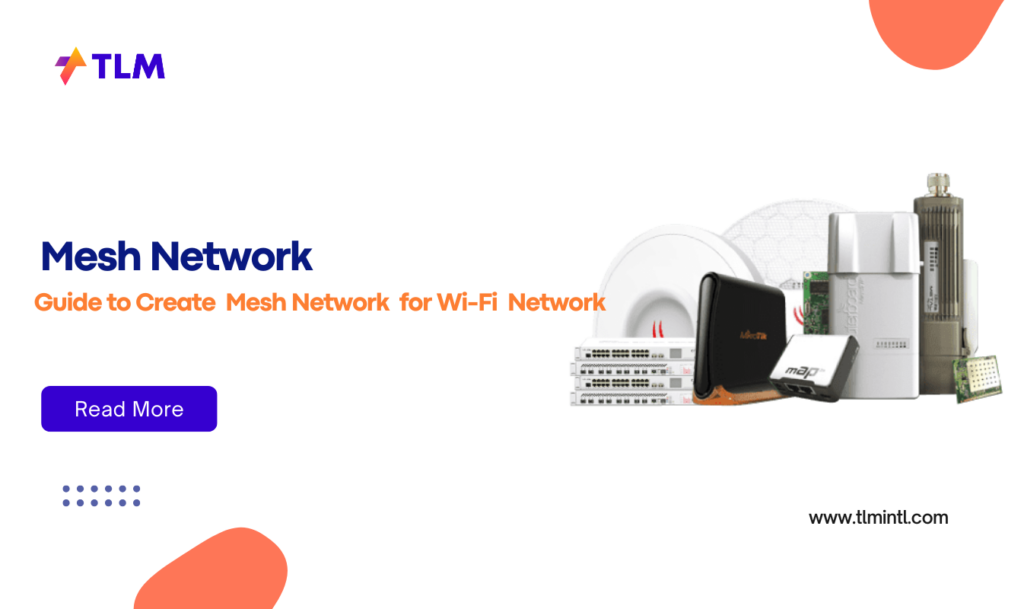In today’s digital age, having reliable and seamless Wi-Fi coverage is essential for both homes and businesses. Traditional routers often struggle to provide consistent coverage, leading to frustrating dead zones. Enter the mesh network—a modern solution designed to blanket your space with strong, uninterrupted Wi-Fi signals. This guide will walk you through creating a mesh network, highlighting key steps, considerations, and products from Ruijie Networks and Ubiquiti.
What is a Mesh Network?
A mesh network consists of multiple nodes or access points that work together to distribute Wi-Fi signals across a large area. Unlike traditional routers that rely on a single point of transmission, mesh networks use multiple nodes to create a web-like structure. This setup ensures that if one node fails, others can take over, providing a self-healing and robust network.
Benefits of a Mesh Network
Eliminates Dead Zones
- By placing nodes strategically throughout your space, you can ensure consistent Wi-Fi coverage in every corner.
Scalability
- Easily expand your network by adding more nodes without complex configurations.
Seamless Connectivity
- Devices automatically connect to the strongest node as you move around.
Easy Installation
- Most systems come with user-friendly apps for straightforward setup and management.
Setting Up Your Mesh Network
Creating an effective mesh network involves several key steps. Here’s how you can set up your system for optimal performance:
Choose the Right Mesh System
Selecting the appropriate mesh system is crucial. Consider factors such as the size of your space, the number of devices connected, and your budget. Brands like Ruijie Networks and Ubiquiti offer reliable options suitable for various needs.
Plan Node Placement
Proper placement of nodes is essential for optimal coverage. Here are some tips:
Central Location
- Place the main router node centrally in your home or office to ensure even coverage.
Avoid Obstructions
- Keep nodes away from thick walls or electronic devices that might interfere with signals.
Overlap Coverage
- Ensure some overlap in node coverage to prevent dead zones.
Connect Your Nodes
Once you’ve placed your nodes, it’s time to connect them:
Use Ethernet Cables
- Connect the main node to your modem using an Ethernet cable for stable internet access.
Power Up Devices
- Turn on each node and wait for them to sync with the main router.
Follow App Instructions
- Most systems provide an app that guides you through the setup process, including naming your network and setting passwords.
Configure Network Settings
After connecting the nodes, configure your network settings:
Set Up SSIDs
- Create separate SSIDs for different frequency bands if needed.
Enable Security Features
- Use strong passwords and enable security features like WPA encryption.
Customize Settings
- Adjust settings such as parental controls and guest networks through the app or web interface.
Test and Optimize Your Network
Testing your network ensures all nodes are functioning correctly:
Conduct Speed Tests
- Use tools like Speedtest to measure signal strength and speed in different areas.
Adjust Node Placement
- If needed, reposition nodes for better coverage based on test results.
Regular Updates
- Keep firmware updated via the app to maintain security and performance.
Recommended Products: Ruijie Networks and Ubiquiti
Both Ruijie Networks and Ubiquiti offer excellent products for setting up a mesh network.
Ruijie Networks
Ruijie offers cost-effective solutions with their Reyee series, which includes routers and access points suitable for small-scale deployments:
RG-EG0G-P Router:
- Features PoE ports and cloud-based management for easy setup.
RG-RAP00(E) Access Point
- Supports PoE power supply with additional LAN port options.
For more information on Ruijie’s offerings
Ubiquiti
Ubiquiti’s UniFi series provides robust performance ideal for larger homes or offices:
UniFi Dream Machine Pro:
- A versatile router that doubles as an NVR or phone system hub.
Wi-Fi Access Points:
- Offer high-speed connectivity with advanced management features.
For detailed specifications on Ubiquiti’s products
Conclusion
Setting up a mesh network can transform your internet experience by providing seamless coverage throughout your space. By carefully selecting your system, strategically placing nodes, and following setup instructions, you can eliminate dead zones and enjoy robust connectivity. Whether you choose Ruijie Networks or Ubiquiti products, you’ll be well-equipped to create an efficient mesh network tailored to your needs.






